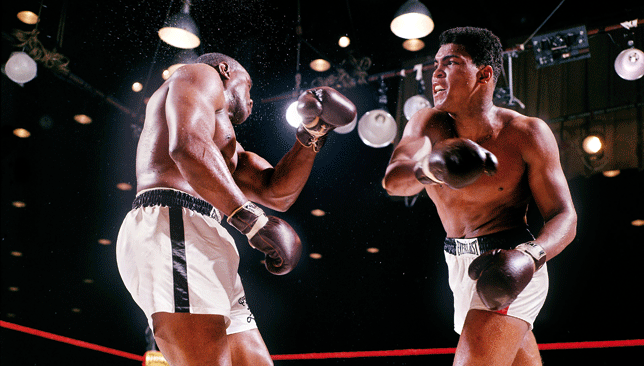
It was the fight that was never meant to happen. Cassius Clay’s own management team, the Louisville Sponsoring Group, were convinced it was too early to put the 22-year-old in the ring with world heavyweight champion, the formidable ex-con Charles ‘Sonny’ Liston, who had gained the title by knocking out champion Floyd Patterson in the first round of their Chicago bout in September 1962.
Cassius Marcellus Clay Jr was himself undergoing a psychic and spiritual metamorphosis – he was soon to become ‘Muhammad Ali’, a name given to him by the leader of his new faith, Elijah Muhammad.
Clay had begun to participate in Muslim meetings as early as 1961, having met ‘Captain’ Sam Saxon, later Abdul Rahaman, while training in Miami and, as the build-up to the Liston fight took place, Clay made careful effort to not fully expose his religious affiliation.
Amongst writers in the know, it wasn’t a secret that Clay was a follower of Elijah and Malcolm X, then a leading figure in the Nation of Islam, who had appeared in Miami pre-fight and was now a firm fixture in the Clay camp.
Clay’s professional career stood at 19 victories and no losses since he’d turned professional in October 1960. However, his last fight before Liston, against Britain’s Henry Cooper at London’s then Empire Stadium (Wembley), in June 1963, resulted in a TKO victory in the fifth round for Clay, but only after he had been knocked down at the end of the fourth by ‘Enry’s ‘Ammer’, the southpaw Cooper’s fabled left hook.
It’s hard to fathom now what convinced Clay that he was ready to take on Liston in a contest that changed the history of the sport precisely 50 years ago today.
His own management, after some effort to dissuade him, negotiated a purse that ended up being $464,595 – around $3.4 million (Dh12.5m) at today’s prices – to protect their young charge against the risk of a premature end to his career.
But that was from a promotion that ended up losing money given a poor ringside attendance of 8,297 at the Miami Beach Convention Hall, with many absent because of the widespread belief that Clay was no match for the fearsome Liston.
Some 43 out of 46 journalists at ringside predicted that Liston would win by a knockout. William Klein’s 1974 documentary, Muhammad Ali the Greatest, chronicles the build-up and is like a step back into a segregation-era United States.

At that point in Clay’s career, he was yet to become Ali and the darling of liberal (anti-Vietnam) America and the film starkly shows that the only firm appeal he had was to those of his own generation within the black community.
Most boxing followers, and most of America, thought he was a big mouth who would end up plastered on the canvas or worse, demolished and in hospital.
What followed catapulted Clay into superstardom and was the first milestone in what is today, the 50-year narrative of Cassius Clay becoming Muhammad Ali, a man who stands alone as the most celebrated sportsman in history, a global icon and perhaps alongside his current President (and ardent fan), the most famous African-American ever.
The fight itself is a revelation to watch. Everything about the ambience of the fight reeks of a past age: the commentator’s antiquated tone, the grainy look of the 16:9 television aspect-ratio (in today’s widescreen age), the look of Liston, the racial make up of people at ringside.
That is everyone except Clay, who 50-years later, looks like a beefed-up and statuesque Pharrell Williams, all smooth skin, lithe, supercilious attitude and practised cockiness. Even in the warm-up announcements, Clay bounces around in his corner, all insouciance and a generation apart from the lumbering, stocky Liston.
He glides around the ring, spends the whole of the first round circling, dancing, pulling away from Liston, rolling under Liston, rolling his head effortlessly away, shifting within Liston’s reach, shifting out of it, all the while his hands never floating higher than his waist.
The opening round alone is a masterclass in athleticism, verve, timing – and with some great dance moves thrown in just for good measure.
Liston’s shady solution
The most dramatic point in the fight comes at the end of the fourth, when Clay’s demeanour turns to panic as he’s confronted by a burning in his eyes and, clearly shaken, insists to cornerman Angelo Dundee (it’s all on camera) that his gloves be cut off.
Dundee shows presence of mind to push Clay back into the fight, exhorting him to keep away from Liston who, sensing blood, goes straight after his befuddled opponent. That was the closest Clay would come to actually being in trouble in the fight.
Dundee believed, probably quite rightly, that Liston’s corner had placed a now forgotten cut disinfectant called Marcel’s Solution on Liston’s gloves before the fourth round in an effort to temporarily blind Clay from Liston’s oncoming punches.
Clay recovers, however, and Liston, humiliated and claiming a dislocated shoulder, refuses to come out for the seventh, giving Clay the title at the age of just 22. He shortly announces his new faith and presents himself to the world as Muhammad Ali. “I shook up the world! I’m a bad man!”
Clay exhorts in the post fight in-ring live interview. In an era of celebrity and non-entity hyperbole, he remains true to his word – he really did shake up the world and 50 years after his first title triumph, we salute him yet again.